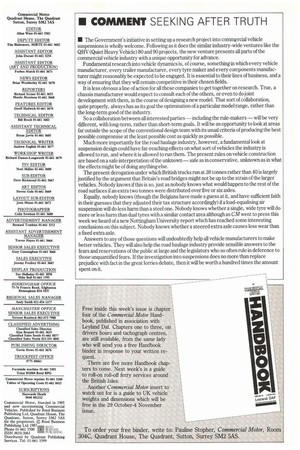• The Government's initiative in setting up a research project
Page 5

If you've noticed an error in this article please click here to report it so we can fix it.
into commercial vehicle suspensions is wholly welcome. Following as it does the similar industry-wide ventures like the QHV (Quiet Heavy Vehicle) 80 and 90 projects, the new venture presents all parts of the commercial vehicle industry with a unique opportunity for advance.
Fundamental research into vehicle dynamics is, of course, something in which every vehicle manufacturer, every trailer manufacturer, every tyre maker and every components manufacturer might reasonably be expected to be engaged. It is essential to their lines of business, and a way of ensuring that they will remain competitive in their chosen fields.
It is less obvious a line of action for all these companies to get together on research. True, a chassis manufacturer would expect to consult each of the others, or even to do joint development with them, in the course of designing a new model. That sort of collaboration, quite properly, always has as its goal the optimisation of a particular model range, rather than the long-term good of the industry.
So a collaboration between all interested parties including the rule-makers — will be very different, with long-term, rather than short-term goals. It will be an opportunity to look at areas far outside the scope of the conventional design team with its usual criteria of producing the best possible compromise at the least possible cost as quickly as possible.
Much more importantly for the road haulage industry, however, a fundamental look at suspension design could have far-reaching effects on what sort of vehicles the industry is allowed to run, and where it is allowed to run them. The present rules on vehicle construction are based on a safe interpretation of the unknown— safe as in conservative, unknown as in what the effects might be of doing anything else.
The present derogation under which British trucks run at 38 tonnes rather than 40 is largely justified by the argument that Britain's road bridges might not be up to the strain of the larger vehicles. Nobody knows if this is so, just as nobody knows what would happen to the rest of the road surfaces if an extra two tonnes were distributed over five or six axles.
Equally, nobody knows (though the Belgians have made a guess at it, and have sufficient faith in their guesses that they adjusted their tax structure accordingly) if a load-equalising air suspension will do less harm than a steel one. Nobody knows whether a single, wide tyre will do more or less harm than dual tyres with a similar contact area although as CM went to press this week we heard of a new Nottingham University report which has reached some interesting conclusions on this subject. Nobody knows whether a steered extra axle causes less wear than a fixed extra axle.
Answers to any of those questions will undoubtedly help all vehicle manufacturers to make better vehicles. They will also help the road haulage industry provide sensible answers to the fears and reservations of the public at large and the legislators who so often rule in deference to those unquantified fears. If the investigation into suspensions does no more than replace prejudice with fact in the great lorries debate, then it will be worth a hundred times the amount spent on it.
























































































































